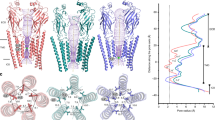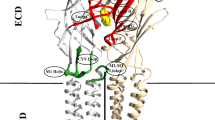Abstract
Our study reports computer software that simulates the work of a single glycine receptor (GlyR). GlyRs have been found in various types of tissues, but their most important role seems to be in neurons, where they hyperpolarise membranes by opening chloride transmembrane channels. The software is based on a combination of two blocks. One block describes the Brownian dynamics of charged particle motion in a dielectric medium, and the other block determines the probability and timing of receptor activation. Using this software, the voltage–current dependencies and time curves of the transmembrane current were obtained. The mean value of the simulated anion current (4.5 ± 0.3 pA) is in good agreement with measured values under identical conditions (\(4.7\pm 0.1\) pA). It was shown that there is a condition under which the GlyR anion channel remains active despite a negligible chloride gradient. Virtual experiments allow evaluation of the value of half maximal effective concentration (EC\(_{50}\)) of the GlyR (\(93\pm 6\) \(\upmu \)M) and confirm that this receptor activates according to a mechanism involving three ligand binding sites. The advantage of the model is the ability to adjust parameters to the precise demands of experimental researchers. Moreover, the introduced algorithm has low computational power demands; therefore, it can be used as a research tool for assistance with structural experiments and applied aspects of neurophysiology.




Similar content being viewed by others
References
Adermark L, Clarke RB, Olsson T et al (2011) Implications for glycine receptors and astrocytes in ethanol-induced elevation of dopamine levels in the nucleus accumbens. Addict Biol 16:43–54
Beato M, Groot-Kormelink PJ, Colquhoun D et al (2002) Openings of the rat recombinant alpha 1 homomeric glycine receptor as a function of the number of agonist molecules bound. J Gen Physiol 119:443–466
Beato M, Groot-Kormelink PJ, Colquhoun D et al (2004) The activation mechanism of alpha1 homomeric glycine receptors. J Neurosci 24:895–906
Betz H, Laube B (2006) Glycine receptors: recent insights into their structural organization and functional diversity. J Neurochem 97:1600–1610
Boronovsky SE, Nartsissov YR (2009) Brownian dynamics description of transmembrane ion flow exemplified with the glycine receptor chloride channel. Biophysics 54:312–315
Boronovsky SE, Seraya IP, Nartsissov YR (2006) Brownian dynamic model of the glycine receptor chloride channel: effect of the position of charged amino acids on ion membrane currents. IEE Proc Syst Biol 153:394–397
den Eynden JV, Ali SS, Horwood N et al (2009) Glycine and glycine receptor signalling in non-neuronal cells. Front Mol Neurosci 2:9
Grudzinska J, Schemm R, Haeger S et al (2005) The beta subunit determines the ligand binding properties of synaptic glycine receptors. Neuron 45:727–739
Li SC, Hoyles M, Kuyucak S et al (1998) Brownian dynamics study of ion transport in the vestibule of membrane channels. Biophys J 74:37–47
Lynch JW (2004) Molecular structure and function of the glycine receptor chloride channel. Physiol Rev 84:1051–1095
Stachlewitz RF, Li X, Smith S et al (2000) Glycine inhibits growth of T lymphocytes by an IL-2-independent mechanism. J Immunol 164:176–182
Vance MA, Gray PD, Tolman KG (1994) Effect of glycine on valproate toxicity in rat hepatocytes. Epilepsia 35:1016–1022
Weinberg JM, Davis JA, Abarzua M et al (1987) Cytoprotective effects of glycine and glutathione against hypoxic injury to renal tubules. J Clin Invest 80:1446–1454
Weinberg JM, Varani J, Johnson KJ et al (1992) Protection of human umbilical vein endothelial cells by glycine and structurally similar amino acids against calcium and hydrogen peroxide-induced lethal cell injury. Am J Pathol 140:457–471
Yamashina S, Ikejima K, Enomoto N et al (2005) Glycine as a therapeutic immuno-nutrient for alcoholic liver disease. Alcohol Clin Exp Res 29:162S–165S
Yin M, Zhong Z, Connor HD et al (2002) Protective effect of glycine on renal injury induced by ischemia-reperfusion in vivo. Am J Physiol Renal Physiol 282:F417–F423
Acknowledgments
Work in the authors’ department has been supported by Medical Scientific and Production Complex BIOTICS Ltd.
Author information
Authors and Affiliations
Corresponding author
Ethics declarations
Conflict of interest
No competing financial interests exist.
Rights and permissions
About this article
Cite this article
Boronovsky, S.E., Nartsissov, Y.R. Computer Simulator of Glycine Receptor Activity: A New Window into a Virtual World. Bull Math Biol 78, 1380–1393 (2016). https://doi.org/10.1007/s11538-016-0183-z
Received:
Accepted:
Published:
Issue Date:
DOI: https://doi.org/10.1007/s11538-016-0183-z




